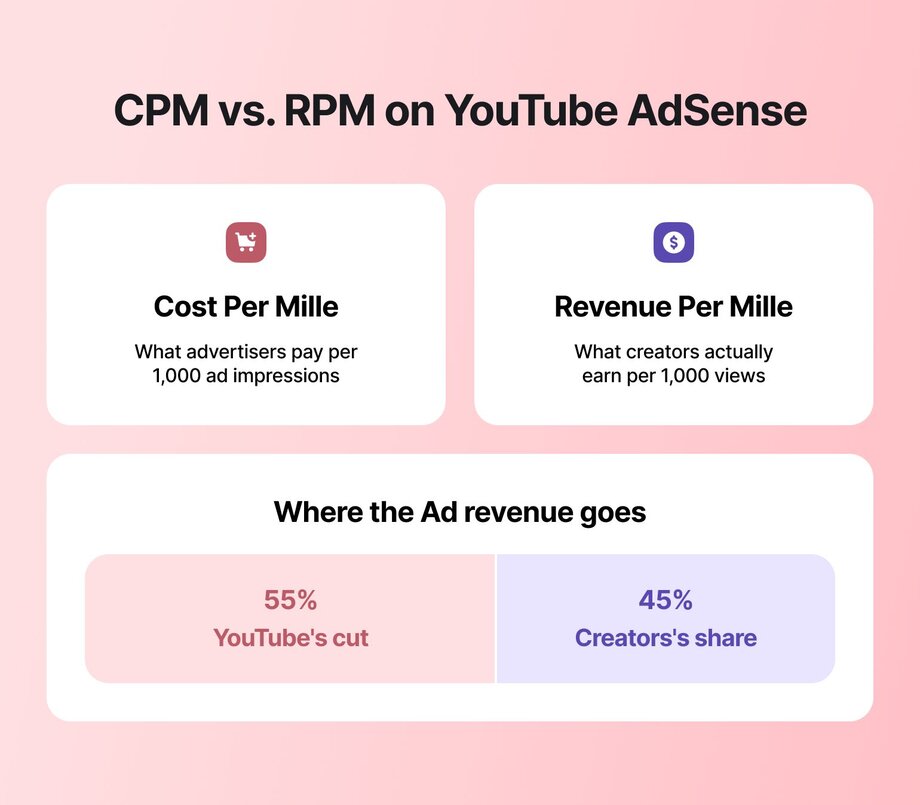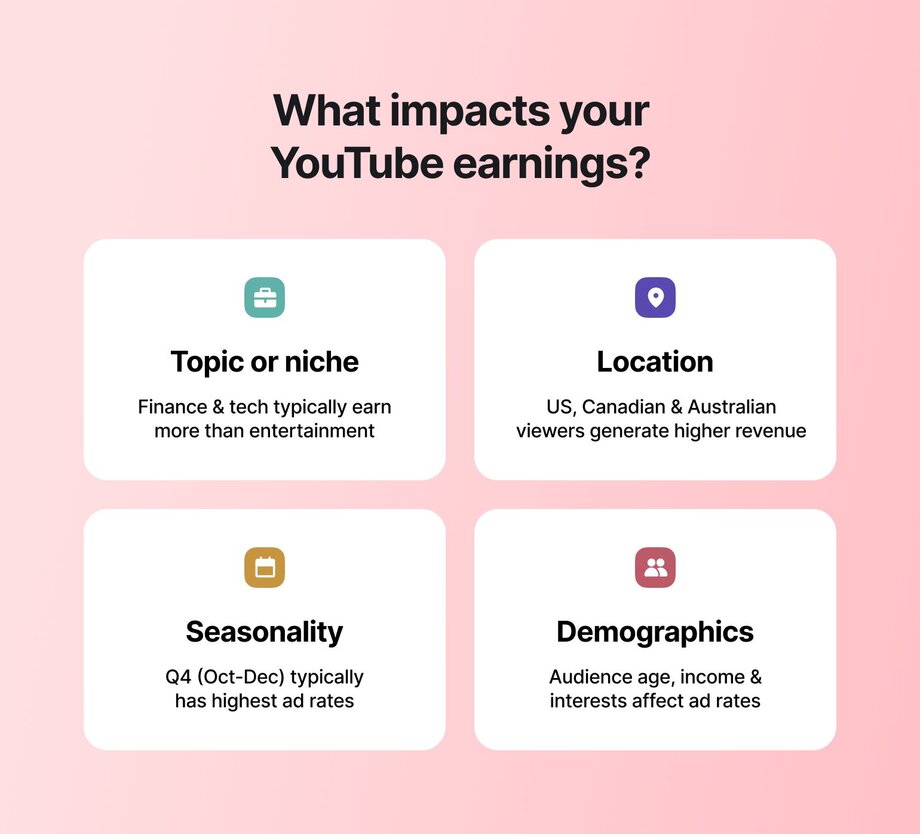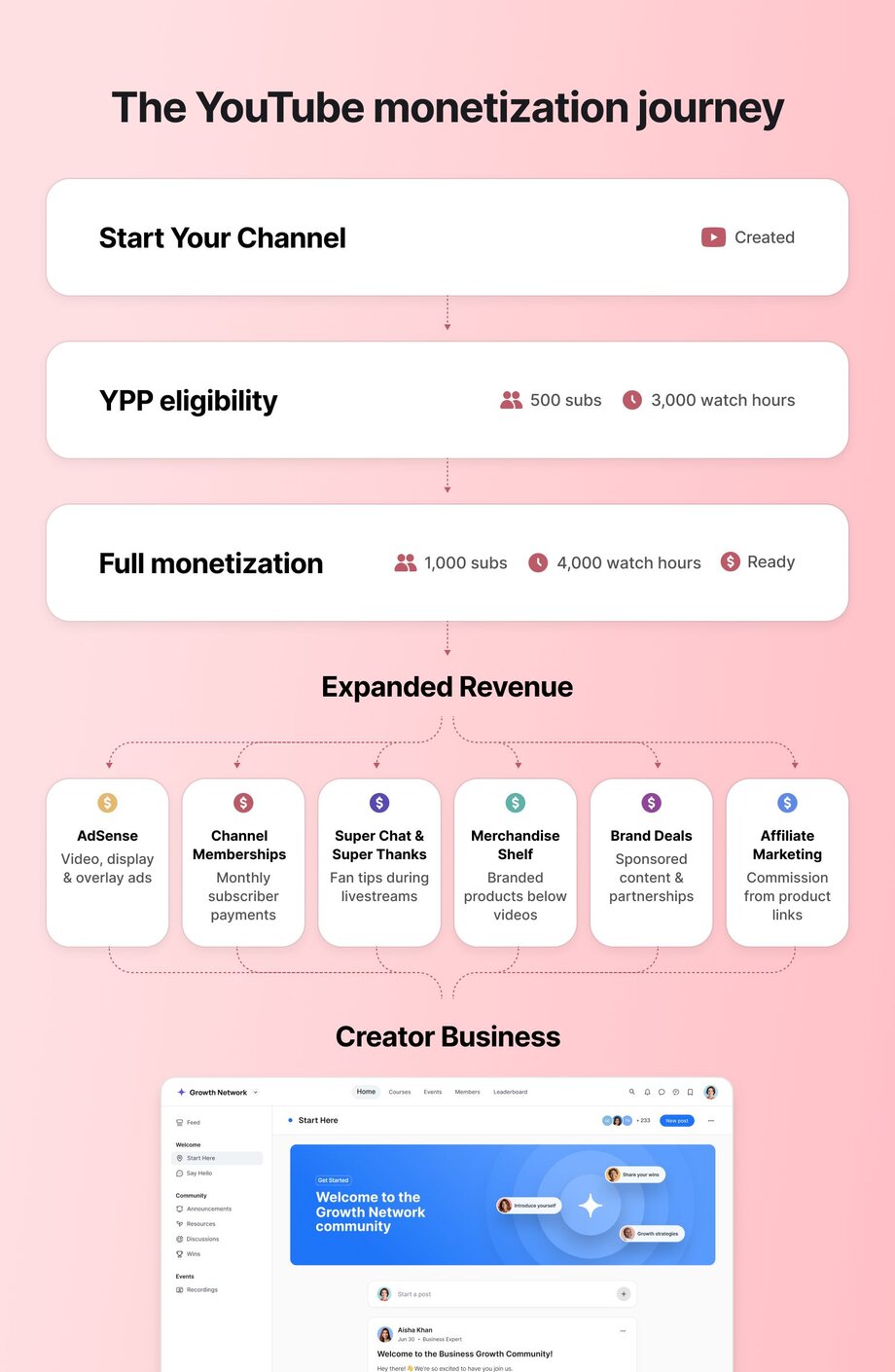Calculating your YouTube earnings: tools, tips, and the secrets nobody tells you
Who knew a simple video shot at a zoo would change how the world shares and consumes content?
YouTube co-founder Jawed Karim was probably hoping for something like that to happen when he posted “Meet at the zoo” in 2005. Fast forward 20 years, and almost 500 hours of video are uploaded to YouTube every minute.
📺 To put that in perspective, if a traditional broadcast TV channel aired content 24/7 without repeating a show, it would take over 82 years to play one day’s worth of YouTube uploads.
(That’s a lot of cat videos.)
Since its early days, YouTube has been a place where a passion project can grow into a business. While the dream of making a living on YouTube is more real than ever, understanding how much you could earn is another story.
Creators often turn to YouTube money calculators to get a sense of what their content could earn, but many only offer ballpark figures that can often feel more like a shot in the dark than science.
Most YouTube money calculators fall short because they rely on broad averages and miss the context. They may use estimated CPM or RPM values without including variables like audience location, video length, engagement rates, and content category.
The result? A lot of wishful thinking and a smaller-than-expected payout.
We feel your pain. That’s why we’ve created a holistic approach to understanding true YouTube return on investment (ROI). In this post, we’re going to:
- Break down the fundamentals of making money on YouTube
- Go beyond AdSense
- Give you the formula for calculating true YouTube ROI
- Look at why locking into one platform is bad for business
- Show real-world examples of how creators make money on YouTube
YouTube monetization 101
We all wish making money on YouTube were as easy as posting a video and waiting for the check to arrive. Before you can start earning serious money on YouTube, you’ll need to take care of some things first.
Meet the YouTube Partner Program (YPP) requirements
You need to be accepted into the YouTube Partner Program to earn money directly through YouTube. That means hitting 500 subscribers and 3,000 public watch hours in the last 12 months. To unlock revenue, you’ll need to reach 1,000 subscribers and 4,000 public watch hours in the last 12 months.
You must also follow all YouTube policies and have a linked AdSense account (more on that later). Once you're in, you can monetize through ads, channel memberships, Super Chats, and more.
What affects how much you earn on YouTube?
When you think of monetization on YouTube, you’re thinking about AdSense. These are the ads that play before, during, or after your videos. Every time someone watches your videos and sees an ad, that view goes towards the formula that calculates earnings.
💡 But not all views are created equal.
Two channels can have very different earnings even with the same number of subscribers or watch time. That’s because RPM—your revenue per thousand views—is influenced by a mix of factors tied to your content and audience.
Scratching your head right now? That’s okay. We get confused, too. It’s important to know the difference between CPM and RPM:

- CPM (Cost per Mille): What advertisers pay per 1,000 ad impressions.
- RPM (Revenue per Mille): What creators actually earn per 1,000 views (creators typically earn around 45% after YouTube takes its cut).
So, what influences your RPM? Here’s what can make the biggest impact:

- 📹 Topic. Finance, tech, and education content attract higher-paying advertisers. More general or entertainment-focused content like vlogs or comedy usually earns less per thousand views.
- 🌍 Location. Advertisers pay more to reach viewers in countries like the U.S., Canada, and Australia, so your earnings can vary greatly depending on where your audience is watching.
- 🏖️ Seasonality. Ad budgets tend to surge during Q4 (October to December) as brands ramp up holiday spending.
- 🧑🏿🤝🧑🏾 Demographics. Age, gender, and income level also influence ad rates. For example, an audience of working professionals in their 30s may bring in more ad revenue than a teen-heavy viewer base.
🎁 Okay, that last point about demographics definitely deserves an asterisk. Young YouTubers like Ryan Kaji of Ryan’s World have built massive followings that translate into eye-popping earnings. According to some estimates, Ryan has earned over $35 million from his toy unboxing videos.
YouTube revenue is more than AdSense
There’s more than one way to earn money from your content. While ad revenue is the most common, YouTube offers several other monetization features that let creators build multiple income streams right on the platform:

- Channel memberships. Viewers pay monthly for exclusive perks like badges, emojis, and members-only content.
- Super Chat / Super Thanks. Fans can tip creators during livestreams or comment sections to show support and stand out.
- Merchandise shelf. Sell branded merch directly from your channel using approved partners, integrated right below your videos.
- YouTube Premium revenue share. Earn a portion of YouTube Premium subscription fees based on how much Premium members watch your content.
Monetizing on YouTube Shorts
Shorts—YouTube’s answer to Reels and TikTok—might be bite-sized, but that doesn’t mean the monetization opportunities are small.
You’ll need to be accepted into the YouTube Partner Program and have a minimum of 1,000 subscribers and 10 million public Shorts views in the past 90 days to earn revenue from your Shorts.
You still earn revenue from ads with YouTube Shorts, but how you earn differs from standard YouTube videos. Instead of ads in your content, YouTube Shorts payouts are based on the ads shown between the Shorts that people watch. Here’s how the payout works:
- YouTube calculates the total Shorts ad revenue globally each month
- YouTube covers music licensing fees for Shorts that use copyrighted music.
- The remaining revenue is split between YouTube and creators, with 45% going to creators based on views.
This means that you earn money based on your share of total Shorts views in the monetized pool for that month, not directly tied to ads on your specific videos.
The good news is that you can use the same monetization opportunities available for long-form content with Shorts. Even better, you can use Shorts to drive traffic to your long-form content to double your revenue-earning opportunities.
Ads aren’t the only monetization options
You don’t have to rely on ads to monetize your channel. The most successful creators turn their audience into a business with brand deals, merch, affiliate links, and direct fan support.
- Sponsored content and brand deals. Partner with brands to create videos that promote their products or services in exchange for payment or perks.
- Affiliate marketing. Earn commission by promoting products and including trackable links in your video descriptions or pinned comments.
- Merch. Sell your branded gear or digital products directly to your audience through platforms like Spring or Shopify.
- Direct support models. Let your most loyal fans support you through monthly contributions in exchange for exclusive content, behind-the-scenes access, or community perks.
Case study: From launch to earnings in one month
Creator Mike Russell launched his channel, Creator Magic, in March 2024, and was already earning revenue by June 2024.
"My strategy for Creator Magic has been to get into a high value niche (AI and coding) that I'm passionate about.
I've found that by consistently publishing practical tutorials and AI tool reviews we've grown AdSense revenue to an average of over $1,600 per month in early 2025 from this channel alone.
While AdSense is our primary monetization method currently, we're beginning to work on targeted sponsorships and the 'secret' is that YouTube serves as an incredible top of funnel."
—Mike Russell, Founder of Creator Magic
Mike is already exploring more direct monetization avenues like premium community memberships to truly own the audience relationship in the future.
👋🏼 Check out his +10,000 strong community on Circle here—and see how he uses AI agents to run his community while he sleeps in the video below.
4 Steps to calculate your true YouTube ROI
Creating content on YouTube isn’t free, and if you want to treat your channel like a business, you need to understand what you’re putting in before you can evaluate what you’re getting out.
(Also, we’re assuming you know ROI stands for “return on investment”. If you didn’t, now you do!)
1. Know what you're really spending to make each video
We’re not saying you need to spend a million on every video like Mr. Beast. But tracking costs like gear, editing, music, and your time gives you a clearer picture of what you're investing in and how it adds up.
2. Ask what you’re giving up to show up on YouTube
Your time has value. Whether it’s client work, freelance gigs, or time with your family, think about the trade-offs that come with each upload.
3. Calculate what your time is actually worth
Knowing your earnings and how much time you spend, you can figure out your real hourly rate.
🧾 Let’s check the receipts. Add up the total hours you spend on creating and promoting a video. This includes research, filming, editing, and creating thumbnails and captions. Divide your total revenue for that video by that number. That’s your actual hourly rate.
4. Your channel is more than just content—it’s an asset
Each video is a long-term investment. Think of your channel like a business. It can generate income over time, open doors to new opportunities, and grow in value with every upload.
Turn your channel into a revenue engine
Understanding your YouTube ROI is only the beginning. Once you have your ducks in a row and are earning revenue, the next step is to increase that return. This means optimizing not just your content but also how you measure success.
📋 How to test what’s actually working
Creating content is an art. Optimizing it is a science. Like any science, the best way to figure something out is by running small, smart experiments and following the data. Here’s a simple way to do it without overcomplicating things:
- Start with a question. What are you trying to figure out? Will a shorter title get more clicks? Does a different thumbnail boost watch time?
- Change one thing at a time. Keep everything else the same so you know what made the difference.
- Run the test. Use YouTube’s “Test & Compare” feature or a tool like TubeBuddy to A/B test titles, thumbnails, or descriptions.
- Look at the results. Focus on click-through rate (CTR), watch time, and retention. What moved the needle?
- Repeat what works. Apply the winner, test something new, and keep refining.
One last tip: Focus on creating videos that stay relevant over time. How-tos, reviews, and educational content are great for this. Evergreen content acts like compound interest: small up-front effort can turn into long-term payoff.
💡 Pro tip: Use Sean Cannell's 7R System to grow your YouTube channel in an time-tested, sustainable way.
Growing your audience into a community
The challenge with YouTube (and Facebook and Instagram) is that the ground can be ripped from underneath you at any moment. YouTube can change its rules, push your videos down the feed, or cut off reach overnight. And if all your audience lives inside YouTube notifications, you’re one change away from starting from scratch.
But since you're here, it’s a good bet that you get that and you’re serious about building a community (and business) that lasts.
The most successful creators are doing more than uploading—they’re capturing attention and building deeper relationships on platforms they actually own. A newsletter. A membership. A community.
🤔 Think of it like this:
- YouTube drives discovery
- Your community drives connection
- Your offers drive revenue
That middle step is where Circle comes in (and turns the whole thing into a powerful flywheel).
With Circle, you can create a branded space where your biggest fans can go deeper with your content, each other, and what you’re building. Whether it’s online courses, forums, office hours, or video content, Circle gives you a way to own the relationship, not rent it.
YouTube can be more than a platform. It can be the start of a new community. Start tracking, testing, and building with intention and see what you can build–then come and start your free 14-day trial to learn how to turn your content into community.